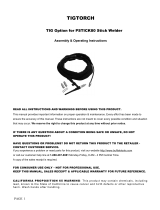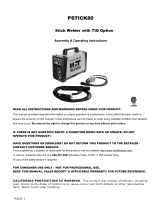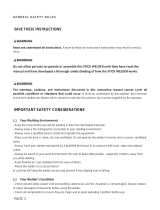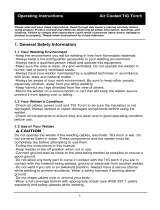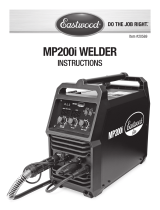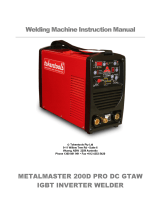Page is loading ...

PAGE 2
G
GENERAL SAFETY RULES
Read and understand all instructions. Failure to follow all instructions listed below may result in serious
injury.
&%&*##&-'()&%)*&&'(*&())$#* )+%* #*.,(* )
$%+#%,,#&'*&(&++%()*% %&&-*-&(")2
The warnings, cautions, and instructions discussed in this instruction manual cannot cover all
possible conditions or situations that could occur. It must be understood by the operator that common
sense and caution are factors which cannot be built into this product, but must be supplied by the operator.
IMPORTANT SAFETY CONSIDERATIONS
1.1 &+(# %%, (&%$%*
- Keep the environment you will be welding in free from flammable materials.
- Always keep a fire extinguisher accessible to your welding environment.
- Always have a qualified person install and operate this equipment.
- Make sure the area is clean, dry and ventilated. Do not operate the welder in humid, wet or poorly ventilated
areas.
- Always have your welder maintained by a qualified technician in accordance with local, state and national
codes.
- Always be aware of your work environment. Be sure to keep other people, especially children, away from
you while welding.
- Keep harmful arc rays shielded from the view of others.
- Mount the welder on a secure bench
or cart that will keep the welder secure and prevent it from tipping over or falling.
1.2 &+(#(3)&% * &%
- Check ground cable, power cord and welding cable to be sure the insulation is not damaged. Always replace
or repair damaged components before using the welder.
- Check all components to ensure they are clean and in good operating condition before use.

PAGE 3
1.3 )&&+(#(
Do not operate the welder if the output cable, electrode, torch, wire or wire feed system is wet. Do not
immerse them in water. These components and the welder must be completely dry before use.
- Follow the instructions in this manual.
- Keep welder in the off position when not in use.
- Connect ground lead as close to the area being welded as possible to ensure a good ground.
- Do not allow any body part to come in contact with the welding wire if you are in contact with the material
being welded, ground or electrode from another welder.
- Do not weld if you are in an awkward position. Always have a secure stance while welding to prevent
accidents. Wear a safety harness if working above ground.
- Do not drape cables over or around your body.
- Wear a full coverage helmet with appropriate shade (see ANSI Z87.1 safety standard) and safety glasses
while welding.
- Wear proper gloves and protective clothing to prevent your skin from being exposed to hot metals, UV and
IR rays.
- Do not overuse or overheat your welder. Allow proper cooling time between duty cycles.
- Keep hands and fingers away from moving parts and stay away from the drive rolls.
- Do not point torch at any body part of yourself or anyone else.
- Always use this welder in the rated duty cycle to prevent excessive heat and failure.
1.4 ' ()&%(1+* &%&((% %
#*( #&"
#*( ( -#() % '(&+ )&" ** % +) %!+(. &( *2 &+ %
#*( ##.# ,'(*)%+)*#)&")%),(+(%)2 #-# %1##$*#
&$'&%%*)&%%**&*- ((#*( ##.&*2&&((&+%&%%* &%)(/(1
)&)+(*(&+%#&(-# %2
- Wear dry protective apparel: coat, shirt, gloves and insulated footwear.
- Insulate yourself from the work piece. Avoid contacting the work piece or ground.
- Do not attempt to repair or maintain the welder while the power is on.
- Inspect all cables and cords for any exposed wire and replace immediately if found.
- Use only recommended replacement cables and cords.
- Always attach ground clamp to the work piece or work table as close to the weld area as possible.
- Do not touch the welding wire and the ground or grounded work piece at the same time.
- Do not use a welder to thaw frozen pipes.

PAGE 4
Fumes and Gases
-Fumes emitted from the welding process displace clean air and can result in injury or death.
-Do not breathe in fumes emitted by the welding process. Make sure your breathing air is clean and safe.
-Work only in a well-ventilated area or use a ventilation device to remove welding fumes from the environment
where you will be working.
-Do not weld on coated materials (galvanized, cadmium plated or containing zinc, mercury or barium). They
will emit harmful fumes that are dangerous to breathe. If necessary use a ventilator, respirator with air supply
or remove the coating from the material in the weld area.
-The fumes emitted from some metals when heated are extremely toxic. Refer to the material safety data
sheet for the manufacturer’s instructions.
-Do not weld near materials that will emit toxic fumes when heated. Vapors from cleaners, sprays and
degreasers can be highly toxic when heated.
%(.)
The welding arc produces ultraviolet (UV) and infrared (IR) rays that can cause injury to your eyes and skin. Do
not look at the welding arc without proper eye protection.
-Always use a helmet that covers your full face from the neck to top of head and to the back of each ear.
-Use a lens that meets ANSI standards and safety glasses.
-Cover all bare skin areas exposed to the arc with protective clothing and shoes. Flame-retardant cloth or
leather shirts, coats, pants or coveralls are available for protection.
-Use screens or other barriers to protect other people from the arc rays emitted from your welding.
-Warn people in your welding area when you are going to strike an arc so they can protect themselves.
(/()
Do not weld on containers or pipes that contain or have had flammable, gaseous or liquid combustibles in
them. Welding creates sparks and heat that can ignite flammable and
explosive materials.
-Do not operate any electric arc welder in areas where flammable or explosive materials are present.
-Remove all flammable materials within 35 feet of the welding arc. If removal is not possible, tightly cover
them with fireproof covers.
-Take precautions to ensure that flying sparks do not cause fires or explosions in hidden areas, cracks or
areas you cannot see.
-Keep a fire extinguisher close in the case of fire.
-Wear garments that are oil-free with no pockets or cuffs that will collect sparks.

PAGE 5
-Do not have on your person any items that are combustible, such as lighters or matches.
-Keep work lead connected as close to the weld area as possible to prevent any unknown, unintended paths
of electrical current from causing electrical shock and fire hazards.
-To prevent any unintended arcs, cut wire back to ¼" stick out after welding.
&**( #)
Welded materials are hot and can cause severe burns if handled improperly.
-Do not touch welded materials with bare hands.
-Do not touch MIG gun nozzle after welding until it has had time to cool down.
'(")4#. %( )
Welding creates hot sparks that can cause injury. Chipping slag off creates flying debris.
-Wear protective apparel at all times: ANSI-approved safety glasses or shield, welder’s hat and
ear plugs to keep sparks out of ears and hair.
#*(&$%* #
-Electromagnetic fields can interfere with various electrical and electronic devices such as pacemakers.
-Consult your doctor before using any electric arc welder or cutting device
-Keep people with pacemakers away from your welding area when welding.
-Do not wrap cable around your body while welding.
-Wrap MIG gun and ground cable together whenever possible.
-Keep MIG gun and ground cables on the same side of your body.
Shielding Gas Cylinders Can Explode
-High pressure cylinders can explode if damaged, so treat them carefully.
-Never expose cylinders to high heat, sparks, open flames, mechanical shocks or arcs.
-Do not touch cylinder with MIG gun.

PAGE 6
-Do not weld on the cylinder
-Always secure cylinder upright to a cart or stationary object.
-Keep cylinders away from welding or electrical circuits.
-Use the proper regulators, gas hose and fittings for the specific application.
-Do not look into the valve when opening it.
-Use protective cylinder cap whenever possible
1.5 (&'((1 %*%%%' (
- Always have power disconnected when working on internal components.
- Do not touch or handle PC board without being properly grounded with a wrist strap. Put PC board in static
proof bag to move or ship.
- Do not put hands or fingers near moving parts such as drive rolls of fan
Do not modify the welder in any way. Unauthorized modification may impair the function and/or safety
and could affect the life of the equipment. There are specific applications for which
the welder was designed.
Always check of damaged or worn out parts before using the welder. Broken parts will affect the
operation. Replace or repair damaged or worn parts immediately.
Store idle welder. When not in use, store it in a secure place out of the reach of children. Inspect it for good
working condition prior to storage and before re-use.
The Power Indicator Light is on when the machine is turned on.
($#(&** &%% *&( *
When the thermal overload indicator is on, it indicates the machine has exceeded the allowable internal
temperature. The machine automatically turns off welding output but the fan will remain on to cool down the
internal components. When the internal temperature had decreased, the machine will automatically turn
welding output back on.
+((%*!+)*$%*
Current adjustment is on the front panel of the machine. It has infinite current output adjustment from 20 to
75 Amps.
&) * ,+*'+*&%%*&(
This is the connector for the electrode holder and cable, most often, when STICK welding. When this
machine is used for TIG welding, this connector is for the grounding cable.
* ,+*'+*&%%*&(
This is the connector for the ground cable and clamp, most often, when STICK welding. When this machine
is used for TIG welding, this connector is for the TIG torch.

PAGE 7
(&+%#%#$'
The ground cable and clamp are attached to the work piece to complete the circuit allowing the flow of current
needed to weld.
# %#%#*(&&#(
One end of the cable is connected to the output connectors of the welder. The electrode is held in the
electrode holder for welding.
&-(&(
The power cord connects the welder to the 120V volt power supply. Plug the 15 amp plug into a
115V/20Amp receptacle to supply power to the welder.
Item Description
Max Amperage 150 amp
Cooling Method Air-Cooled
Duty Cycle 35% @ 150 amp
Suggested Tungsten .020 to 1/16"
Torch Cable Length 10 ft.
Torch Style 17V
Weight 3 lbs.
KNOW YOUR TORCH
)( '* &%
This Air Cooled TIG torch is designed to operate with the PSTICK80 welder for welding on steel or
stainless steel. This torch is ideal for light fabrication, welding repair and maintenance operations.

PAGE 8
&(#
The 10 ft. long torch cable delivers the welding current and shielding gas to the arc.
)#&-#,
This torch gas connection goes directly to the inert regulator/flowgauge connected to your bottle of shielding
gas. This valve controls the flow of shielding gas for welding.
&//#
Three nozzles are supplied with this TIG torch. These nozzles direct the flow of the shielding gas from the
TIG torch to the arc
&##*
Three collets are supplied with the TIG Torch. They are sized to the size of the tungsten you will be using.
They hold the tungsten into the TIG Torch.
%(*)&%%* &%
This connection is used to connect your source of shielding gas to the TIG torch. Connect this
connection to your shielding gas regulator.
0
Prolonged exposure to the welding arc can cause blindness and burns. Never strike an arc or begin
welding until you are adequately protected. Wear flame-proof welding gloves, a heavy long sleeved
shirt, trousers without cuffs, high topped shoes, and an ANSI approved welding helmet.
1. INSTALLATION OF TIG TORCH
1.1 Remove the ground cable and the electrode holder from the weld output connections. Install the ground
cable to the Positive (+) weld output connection.
1.2 Secure the ground clamp to the work piece
1.3 Connect a regulator to a bottle of ARGON gas. Then connect the gas connection from the TIG torch to
the regulator.
1.4 Connect the TIG torch weld cable to the Negative (-) weld output connection.
1.5 Set desired amperage on the amperage control knob on the front panel of the welder.
1.6 Turn on the input power switch on the welder.
Be aware that the TIG torch will be electrically HOT when the Input Power Switch on the welder is turned on.
1.7 Turn on the regulator on the bottle of shielding gas and adjust the regulator to approximately 20 CFH.
Then open the shielding gas valve on the torch to start the flow of shielding gas.
1.8 Touch the tungsten that is installed in the TIG torch, to the work piece and quickly pull away
approximately 1/4" to create an arc.

PAGE 9
0
Prolonged exposure to the welding arc can cause blindness and burns. Never strike an arc or begin welding
until you are adequately protected. Wear flame-proof welding gloves, a heavy long sleeved shirt, trousers
without cuffs, high topped shoes, and an ANSI approved welding helmet.
Be aware that the TIG torch will be electrically HOT when the Input Power Switch on the welder is turned on.
1. Remove the ground cable and the electrode holder from the weld output connections. Install the ground
cable to the Positive (+) weld output connection.
2. Secure the ground clamp to the work piece
3. Connect a regulator to a bottle of ARGON gas. Then connect the gas connection from the TIG torch to
the regulator.
4. Connect the TIG torch weld cable to the Negative (-) weld output connection.
5. Set desired amperage on the amperage control knob on the front panel of the welder.
6. Turn on the input power switch on the welder.
7. Turn on the regulator on the bottle of shielding gas and adjust the regulator to approximately 20 CFH.
Then open the shielding gas valve on the torch to start the flow of shielding gas.
8. Follow these steps for striking an arc while TIG welding.
8.1 Open the shielding gas valve on the torch handle to begin gas flow.
8.2 Rest the TIG torch nozzle on the work piece taking care to not touch the installed tungsten
electrode.
8.3 Twist the torch to make contact between the work piece and the tungsten.
8.4 Lift torch away from the work piece about 1/8 inch.
8.4 Move down the joint to be welded by pushing the torch.
8.5 Insert filler metal in the leading edge of the weld puddle as needed.
/
